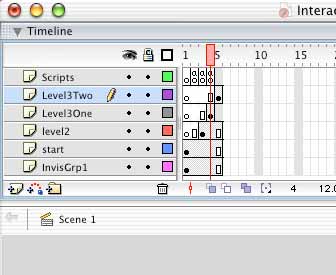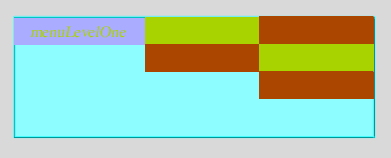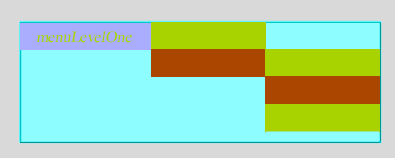Interactive Menu Demonstration
To set up a similar menu in Flash, set up your timeline
and buttons in flash in the following manner:

The scripts layer has three frame scripts: they merely
stop the play of the movie for each frame, while other scripts tell
the
play head to go to frames on which the interactive sub-menus are placed.
The blue band is level one, the swatch twice as wide and having a green
and a red stripe is level two, and level three consists of the two
menus that show based upon a rollover of one of the stripes in level
two.
Level one is "start" which spans the entire duration.
The play head plays when the movie is started and stops at two so that
only the start button is visible (the other parts of the menu are not
visible until we get to frames three, four, and five).
Proceeding down the layer window, we have level two,
the maroon and olive buttons in the middle. These buttons span frame
three (its appearance with the rollover of the start button (the light
blue button with olive text), frame four (its continued appearance
along with Level3One), and frame five (its continued appearance along
with Level3Two). Level3One is shown below, and is only present in frame
four. Every time I mouse over the green button in level2, the play
head jumps
to frame four where the entire menu is visible except for Level3Two.

Similarly upon rollover of the red button, the Level3Two
is visible along with the rest of the menu. The frame five in which
it is only visible encapsulates the red, green, and red stripes, each
button instances with their own scripting possibilities. The frame
acts as a code construct for the three buttons, containing them in
the computer's mathematical language.

The bottom, largest layer is a large invisible button
that helps to close the menus when the user mouses outside of them,
and act as an area not
on
a higher
level menu that would cause the submenu to pop up again.
The Procedures: Levels one
and two each have events associated with them: when a user mouses over
the buttons in these layers, sub-menus appear (the mechanism is a goto
frame script).
2) This allows the sub-submenu to appear when the users
mouses back over the higher level button from the middle submenu,
since it goes to frame four or five--and both must have a script that
deals
with level two's visibility which is in not only four and five, but
in three too.
3) When the mouse moves in from the third level to the
first level, there is a goto script in the first level that moves
the playhead to before frame three. The key to this functionality is
the use of a single frame for the objects
(the large invisible button, and the start menu)
that spans more than one frame, so that its scripts will be applied to
the other buttons in all of those frames. You may also retrieve the
current frame before and after the playhead jumps to the submenu, thereby
potentially
doing away with the invisible button (only advanced flash users need
go here!).
On Symbols: When we use symbols
in Flash, we are encapsulating numerical sources. Encapsulation in
computer programming is a term for data boundaries--domains for the
scope of functions attributed to computer code snippets. So let us
say that you had a picture of a famous artist, drawn using the drawing
tools in flash. There are three components which go into the visual
image on the screen: the mathematical description or source, the instructions
on how to draw the image from the mathematical description, and the
visuals themselves.
The mathematical description encapsulates or describes
through being a container for an object. This sounds abstract, but
it is really only a notion of numerical representation and simulation.
How would you go about modeling events, actions and animation, through
numbers?
There are two dimensions: what machines read, and what
humans experience, although what machines read, humans can also experience
or decipher. Computer programs, in order to be flexible need to be
able to separate data from procedures. Why? We need to be able to describe
processes or behaviors into which we can then plug data. We do this
when we copy elements in Flash or any other program, where the behavior
is "copy".
Imagine if you had to write a new program every time
you wanted to copy something different. The computer would have no
value as a tool. The separation of data from procedures removes this
obstacle.
In Flash, a symbol is visual, but it constitutes a pattern
for copies. The notion of an instance is important here: an object
has a description that can be instanced, or in other words, data can
be represented. |

